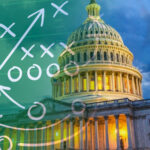Piercing the Veil
In November of 1943, speaking to Joseph Stalin during the Tehran conference, Winston Churchill remarked that, “In wartime, truth is so precious that she should always be attended by a bodyguard of lies.” When the going gets tough, those in positions of power and influence often opt to soften the hard edges of tough truths to paint a portrait of reality that’s more agreeable than the underlying facts justify. As Churchill’s words attest, the fog of war is thick. That fog is just as thick when observing policymakers, markets, and the economy. Now, as ever, we must endeavor to pierce its veil.
This week, with a tip of the hat to Churchill, Fed Chair Powell manufactured a bit of his own fog at the post-FOMC meeting press conference. Powell’s portrait of the economy was certainly painted to soothe. As the Chairman put it, “Recent indicators suggest that economic activity has continued to expand at a solid pace.” As for a progress report on the dual mandate, Powell said “Inflation has eased notably over the past two years, but remains somewhat above our longer-run goal of two percent… Overall, a broad set of indicators suggests that conditions in the labor market have returned to about where they stood on the eve of the pandemic—strong but not overheated.”
It all amounts to a pretty picture. All that remains, it would seem, before we reunite with full economic bliss is that pesky last mile of the inflation fight. Accordingly, on Wednesday Powell informed us that “Today, the FOMC decided to leave our policy interest rate unchanged and to continue to reduce our securities holdings. We are maintaining our restrictive stance of monetary policy in order to keep demand in line with supply and reduce inflationary pressures.”
What’s not to like? Apparently, the Fed has safely and softly landed the economy. All that remains is some final fine-tuning to shove inflation that last mile down to target. We’ll be there in no time. Bravo to our great and powerful monetary maestros.
But recall last week’s warning from former Federal Reserve Bank of New York president Bill Dudley in his Bloomberg Op-Ed titled, “I Changed My Mind. The Fed Needs to Cut Rates Now.” In it, Dudley wrote, “The Fed should cut, preferably at next week’s policy-making meeting… [because] although it might already be too late to fend off a recession by cutting rates, dawdling now unnecessarily increases the risk.”
Well, that’s certainly not the same pretty picture Powell described on Wednesday. What does Dudley see? Remember, monetary policy works with “long and variable lags.” Perhaps Dudley sees the risk of maintaining a restrictive policy that lags when the rate of deteriorating economic data is already beginning to notably accelerate to the downside. Perhaps Dudley sees the risk of a budget-busting recession on top of the already “debilitating” and rapidly escalating deficit that’s further piling on to the $35 trillion US government debt load.
One thing Dudley certainly perceives through the fog, however, is that while “a broad set of indicators suggests that conditions in the labor market have returned to about where they stood on the eve of the pandemic,” the fed funds rate then was under 2%. Now it’s well over 5%.
Furthermore, a pre-pandemic standard may not be the ideal benchmark to shoot for. After all, even with a fed funds rate under 2% in late 2019, many economic indicators were already pointing toward an incoming recession regardless of Covid lockdowns.
This week, data seemed to back Dudley’s concern over keeping rates restrictive in the face of a possible incoming recession. In one short week the market shifted dramatically from concern over inflation to seeming panic over a growth slowdown, with all eyes on the labor market.
Employment data certainly took the spotlight, and it disappointed across the board. Data included a very weak JOLTS report on job openings in the private sector, ADP private payrolls that significantly undershot estimates, and worse-than-expected initial and continued jobless claims that are now tracking weaker than the normal seasonal pattern. In fact, at 1.94 million, continuing jobless claims are at their highest level since July 2017 except during the pandemic. Then on Friday, the July non-farm payroll report emphatically underwhelmed with a 114,000 increase in payrolls vs. the 175,000 expected. May and June also saw a combined negative 29,000 payroll revision lower than previously reported.
With the weaker-than-expected non-farm payrolls, the U3 Unemployment Rate unexpectedly increased to 4.3% vs. 4.1% expected and 4.1% previously. That marks a significant milestone for the up-trending unemployment rate. Now 90 basis points off the low point of the cycle, the U3 unemployment rate has triggered the “Sahm rule,” a recession indicator developed by former Fed economist Claudia Sahm, which has a perfect track record over the last half-century. There is an open question as to whether, and to what extent, the hurricane in Texas impacted the monthly jobs numbers, but what’s far more important is the accelerating trend toward a weakening labor market. That trend should be taken seriously given that it’s been well forecast by the leading economic indicators and the leading employment data since late 2022.
Additionally, the more comprehensive U6 Unemployment Rate jumped to 7.8% from 7.4% previously. Furthermore, on a six-month annualized basis, HAI’s six factor coincident employment index finally turned negative for the first time this cycle. That dip into negative territory is notable. Historically it hasn’t happened outside of recession or the few months immediately preceding one. Making matters worse, after several months of stabilization, leading indicators of employment also took a nosedive in July to new cycle lows, implying further labor market weakening ahead.
Lastly, the ISM Manufacturing PMI was flat-out bad. ISM came in at a contractionary 46.8 vs. 48.8 expected and down from 48.5 previously. Worse than the headline, however, was the continued decline in two leading indicators. New Orders slid to 47.4, and Backlogs registered a deeply recessionary 41.7.
Worse yet, in keeping with the theme of the week, was the Employment Index. ISM’s Manufacturing Employment Index crashed to 43.4 in July from 49.3 in June. For perspective, this very same survey sub-index was 45.4 in September of 2008. That was 10 months into the Great Recession and after the survey reflected that month’s failure of Lehman Brothers.
That’s spooky, but the frights didn’t stop there. The ISM survey underperformed its 2008 comparable in another way. The two of 18 industries the ISM tracks monthly with expanding Employment plus the two industries with the confidence to grow Inventories sums to four, and that is the lowest since the tally of five—also in September of 2008.
Now, the Fed and the market would likely be extremely relieved if these deteriorating economic trends stopped on a dime. According to orthodox monetary policy theory, if you want an economy that’s neither too hot nor too cold, then the policy setting for just right should be “neutral.” The problem is that monetary policy is a notoriously blunt instrument, and nobody knows the exact setting for neutral in real-time. That said, Bill Dudley certainly doesn’t think neutral is today’s 5.5% on the fed funds rate, and that’s where Jay Powell has us parked until September.
Dudley isn’t alone. This week, Bank of America Chief Investment Strategist and HAI favorite Michael Hartnett warned that the risk of a hard landing is “clearly rising.” Similarly, in an interview with CNBC on Wednesday, famed “bond king” Jeff Gundlach said that when Powell cuts rates in September “history will record that we were already in a recession” and added that he certainly anticipates “many more cuts coming than the market currently expects.” According to Gundlach, however, “by the time the Fed cuts, it will be too late.”
Notably, after all the soft-landing enthusiasm of the last year, this week’s market action had the look, feel, and smell of a recognition moment. It looked like a market that suddenly agrees with Dudley, Hartnett, and Gundlach. The dramatic change in market sentiment appeared to acknowledge that the hard part of a hard landing may indeed be imminent, and that Fed rate cuts will be too late to fend off the recessionary tidal wave. If so, it could be lights out at the stock market casino—for a while.
Just three short weeks ago, the market priced in only two expected “adjustment” Fed rate cuts for the remainder of the year. As of Friday, with fresh data in hand and Powell looking late on the draw, markets have shifted dramatically. Suddenly markets are now pricing in a 70% chance of a hefty 50-basis point cut in September and are even pricing in a 61% chance of a 125-basis point cut (or five 25-basis point cuts) by year-end. That’s certainly the market signature of a recognition moment, and that writing is now on the wall.
These are no longer benign fine-tuning “adjustment” cuts. The market is now increasingly expecting the sort of emergency cuts consistent with a Fed that’s late and responding to recession or crisis. Having cut through the fog of war, markets may now be starting to front-run the historical tendency for stocks to fall once the Fed starts cutting in the face of a hard landing. Accordingly, stocks sold off violently late in the week. The selling was heavy and indiscriminate.
Remember that all of this is happening amid a sovereign debt crisis in which the US government has $35 trillion in total debt, 122% debt/GDP, 7% deficit/GDP (at full employment), and a debt servicing charge that’s larger than the defense budget. If nominal GDP growth falls too close to interest rates, let alone falls below rates, HAI’s long talked about debt spiral dynamics will likely kick in with vigor. That means dramatically lower rates and some form of stimulus are likely coming—and soon. In HAI’s view, the biggest question remains just how much pain lies between here and there? But like a beacon piercing the fog, gold’s new all-time high this week provides important clarity. In HAI’s view, gold knows the Fed is trapped, it’s sniffing out the stimulus to come, and it senses it won’t be long in coming.
Weekly performance: The S&P 500 was down 2.06%. Gold was up 3.73%, silver was up 1.33%, platinum was up 2.46%, and palladium was off by 0.50%. The HUI gold miners index was slightly higher, up 0.20%. The IFRA iShares US Infrastructure ETF was off 2.73%. Energy commodities were volatile and down on the week. WTI crude oil was down 4.72%, while natural gas was off 4.10%. The CRB Commodity Index was off 2.62%. Copper was lower by 0.51%. The Dow Jones US Specialty Real Estate Investment Trust Index was up 4.08%. The Vanguard Utilities ETF was up 4.01%. The dollar index was down 1.03% to close the week at 102.99. The yield on the 10-yr U.S. Treasury crashed by 41 bps to close at 3.79%.
Have a wonderful weekend!
Best Regards,
Morgan Lewis
Investment Strategist & Co-Portfolio Manager
MWM LLC















